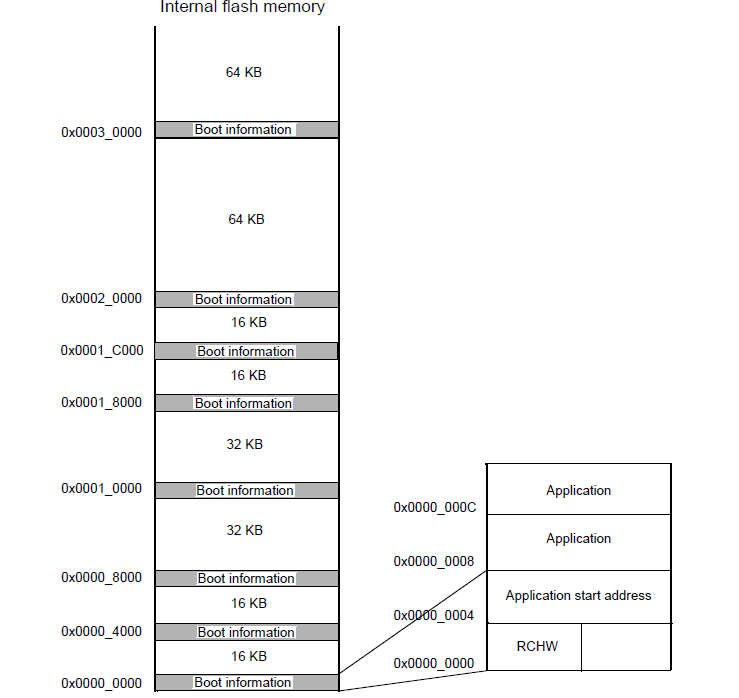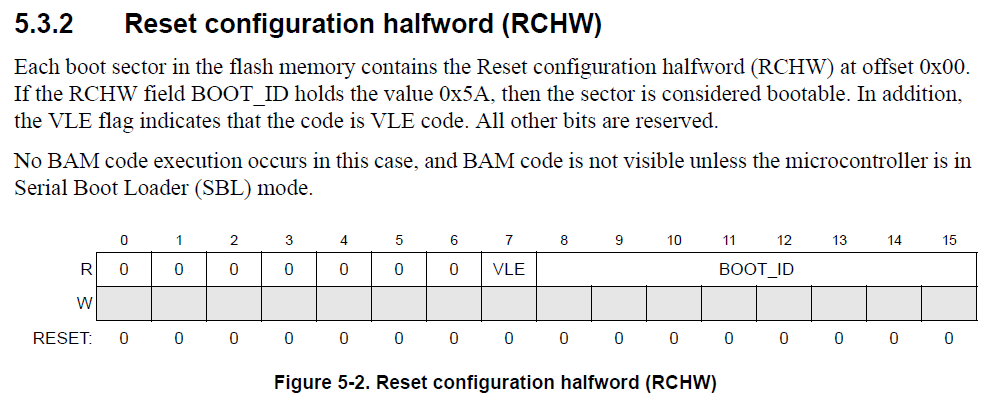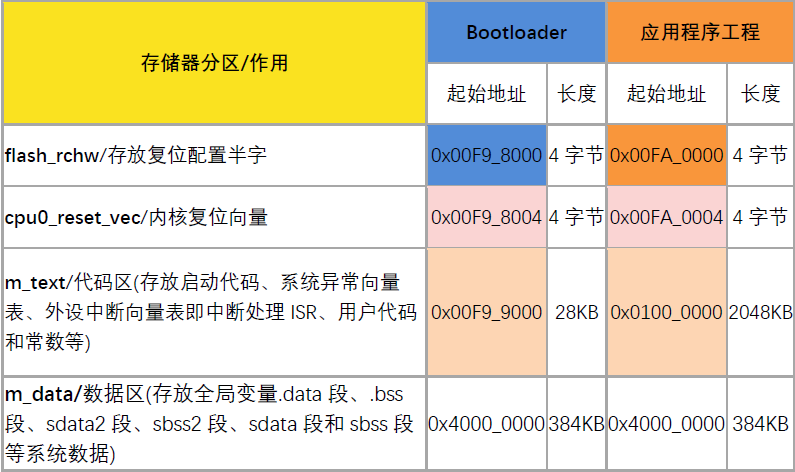了解BootLoader——基于MPC5744P Bootloader例程
一、BootLoader的作用:BootLoader是固化在PFlash中的一个程序,其作用可以分为两部分:boot和load。
(1)boot:MCU上电时首先会运行BootLoader程序(因为它一般位于PFlash最前面的启动区,接下来会谈到启动区Boot location的概念),BootLoader程序会初始化系统时钟、看门狗等以保证系统的正常运行,此外还会初始化CAN(也可以是串口、SPI等)以实现和上位机的通信。
(2)load:系统初始化完成后,程序会进入等待状态,如果在预定时间内没有接收到上位机的程序下载请求信号(CAN帧),则跳转并执行MCU内部原有的用户应用程序(位于PFlash的其他启动区)。如果在预定时间内接收到来自上位机的程序下载请求信号,则BootLoader程序进入新程序下载状态。下载过程中,上位机与BootLoader程序之间采用一问一答的方式逐行的下载S19文件(用户应用程序的可执行文件)并进行解析,得到程序地址和程序数据,从而将每一行程序数据按照程序地址写入到PFlash中。程序下载完成后,清除RAM,关闭CAN等BootLoader用到的外设,跳转到新的用户应用程序并开始执行。
二、Boot location的概念:Boot location就是每次MCU复位后运行BAM(Boot Assist Module)时寻找合法复位配置半字RCHW(Reset Configuration Harf-Word)和应用程序开始地址(Application Start Address,也可以叫做应用程序复位向量地址(Reset Vector)的区域。复位后CPU将从Boot location0~7依次查找由正确Boot_ID--0x5A组成的合法复位配置半字和应用程序开始地址,从而执行用户应用程序。MPC5744P有8个Boot location,在Flash Memory Map中标明了哪些block可以作为Boot location,如下图:

Boot location的组成如下图所示:

Boot location的起始位置是复位配置半字(RCHW),其结构如下所示。

只有设置了真确的BootID,该Boot location才被识别为可启动的,如BootLoader程序和用户应用程序生成的S19文件:

在BootLoader程序的S19文件第二行中,0x00F98000为Boot location_0的起始地址,也就是RCHW的地址,其中存放的数据为0x01_5A,RCHW的VLE位置1,BOOT_ID为0x5A,即配置该Boot location为可启动的。reserve的16-31位默认为0x00

从用户应用程序的S19文件第三行可以看到,0x00FA0004为用户应用程序开始地址(应用程序复位向量地址),其中记录的数据0x0100000为应用程序的复位函数地址,也就是应用程序真正开始执行的地址。因此,一般用如下方法实现到用户应用程序的跳转:
#define APP_StartAddr (*(uint32_t*)0x00FA0004) (*(void (*)(void))(APP_StartAddr))();
三、BootLoader程序和用户应用程序App在PFlash中的位置关系(Flash分配)
对BootLoader程序和用户应用程序的 link_file做如下设置:
MEMORY //BootLoader { /*16 KB low flash memory block 2 (boot location 0) from 0x00F98000 to 0x00F9BFFF*/ /*16 KB low flash memory block 3 (boot location 1) from 0x00F9C000 to 0x00F9FFFF*/ /* use the low flash memory block 2 and 3(32KB in total) as bootloader area */ flash_rchw : org = 0x00F98000, len = 0x4 cpu0_reset_vec : org = 0x00F98004, len = 0x4 m_text : org = 0x00F99000, len = 28K /*code flash for bootloader interrupt vector table, startup and boot codes*/ m_data : org = 0x40000000, len = 384K /*system SRAM*/ local_dmem : org = 0x50800000, len = 64K /*CPU core data tightly coupled memory*/ }
MEMORY //User App { flash_rchw : org = 0x00FA0000, len = 0x4 cpu0_reset_vec : org = 0x00FA0004, len = 0x4 m_text : org = 0x1000000, len = 2048K m_data : org = 0x40000000, len = 384K local_dmem : org = 0x50800000, len = 64K }
则BootLoader和App的在PFlash中的关系如下:


四、S19文件结构:

五、数据对齐问题:
例程中的对齐函数主体及注释如下:
stafno = (srcd_t->addr&0x7)>>1; /* number of uint16_t need to be pre-staffed */ //if addr is not a multiple of 8-Bytes, get the surplus bytes then >>1 srcd_t->addr &= 0xFFFFFFF8; /* align data base address at 4W */ //about why >>1(divided by 2 regardless odd num addr): maybe there isn't odd address if(stafno) { for(i=srcd_t->dtlen; i>0; i--) srcd_t->data[i+stafno-1] = srcd_t->data[i-1]; // move forward data in number of stafno srcd_t->dtlen += stafno; // update dtlen while(stafno--) srcd_t->data[stafno] = 0xFFFF; // pre-staff 0xFFFF } while((srcd_t->dtlen&0x000003)!=0) // need to append post-staffing uint16_t //if data num is a multiple of 4(each data is uint_16, so it's a judge of 64bits - 8bytes) srcd_t->data[srcd_t->dtlen++] = 0xFFFF; //if not enough 4*uint_16 - 8bytes, padding with 0xFFFF behind data's tail } // conclusion: address is aligned with 8bytes by &0xFFFFFFF8, but data field will not move accordingly, // it just padding with 0xFF in the front of array, so as to accord with origin address(0x0004) correctly // // address data(uint16) address data(uint16) // |0x0000| |0x0000|<-- 0xFF // |0x0002| after |0x0002| 0xFF // |0x0004|<-- 0x55(data[0]) =======>> |0x0004| 0x55 // |0x0006| 0x66 address |0x0006| 0x66 // |0x0008| 0x77 align |0x0008| 0x77 // |0x000A| 0x88 |0x000A| 0x88 // |0x000C| |0x000C| // // note: (1) i guess that 0xFF will not be recognized as a instruction by CPU, so CPU fetch instruction from 0x0000 // but execute from 0x0004 in fact. // (2) and note that the graph above is base on the struct SRecord_t, // so that data[0] is always correspond with base address(SRecord->addr)
其中srcd_t的结构如下:
typedef struct { uint32_t addr; uint32_t dtlen; // num of valid data uint16_t data[20]; } SRecord_t;
另外,关于数据对齐问题,可以参考博文:https://blog.csdn.net/maxlovezyy/article/details/70231804
六、其他:下图为建立多核工程时的Flash和RAM资源的分配,可以用来参考以加深对程序在内存中的存储的理解



